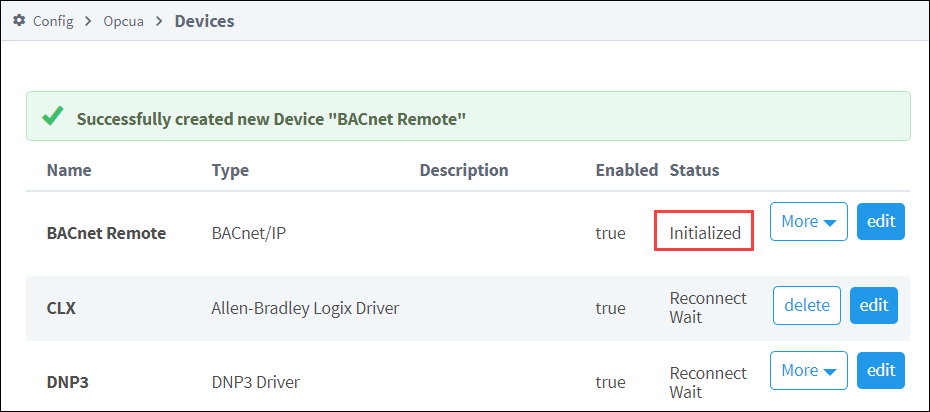BACnet Remote Device
Once a local device has been configured a remote BACnet device can be added. You must know the IP address and device number of the remote device to configure a connection.
UDP is a connectionless protocol so a device is considered connected or initialized once Ignition has sent a Who-Is, received an I-Am, and then interrogated the remote device for some basic properties, including its object list and the supported properties of each object.
The object and properties are cached and subsequent connection attempts will only re-read them if the Database_Revision property changes. You can invalidate the browse data under the “More” menu for a given device (Config > OPC UA > Device Connections) on the devices page in the Ignition Gateway.
Connect to a Remote BACnet Device
Go to the Config section of the Gateway Webpage.
Scroll down and select OPC UA > Device Connections.
On the Devices page, click on Create new Device.
Select BACnet/IP, and click Next.
Select the local device from the dropdown. If no local devices are shown, you'll need to set one up first. See BACnet Local Device.
Fill in the following fields:
- Name: BACnet Remote
- Remote Address: Enter the IP address, for example 10.10.###.##
- Remote Device Number: The instance number of the remote device you're setting up.
Leave the default values in the remaining fields.
Click Create New Device.
The Devices page is displayed showing the BACnet/IP device is successfully created and added to Ignition.

Device Settings
General
| Property | Description |
|---|---|
| Name | Device name. |
| Description | Device description. |
| Enabled | Default is set to true. |
Other
| Property | Description |
|---|---|
| Local Device | The name of the local BACnet device instance that will be used when communicating with the remote device. If no local devices are shown, you'll need to set one up first. See BACnet Local Device. |
| Remote Address | The hostname or IP address of the remote device. |
| Remote Port | The port that the remote device is listening on. Default is 47,808. |
| Remote Device Number | The instance number of the remote device you're setting up. Default is 1. |
| Write Priority | The priority to use when writing to commandable properties. Default is 8. |
| COV Enabled | If true a Change of Value (COV) subscription is used for properties that support it. If false all properties are polled. Default is true. Note: COV subscriptions are only applied to Present_Value and Status_Flags. |
| COV Heartbeat Interval | Interval, in seconds, between reading the System_Status property of the Device object as a heartbeat. If three consecutive attempts fail, all COV items will be marked with uncertain quality. Default is 5. |
| COV Subscription Lifetime | Lifetime, in seconds, of COV subscriptions. Use 0 for indefinite. When non-zero COV subscriptions are renewed at a rate of 75% of the lifetime. Default is 900. |
| COV Subscription Retry Interval | New in 8.1.33 Interval, in seconds, to attempt recreating COV subscriptions that previously failed to be created or renewed. Use 0 to have failed subscription items remain polled. Default is 120. |
| Confirmed Notifications Enabled | If true COV subscriptions use confirmed notifications. If false COV subscriptions use unconfirmed notifications. Default is false. |
| Discovery Timeout | New in 8.1.4 Duration, in seconds, to wait for the remote device discovery process to complete. Default is 5. |